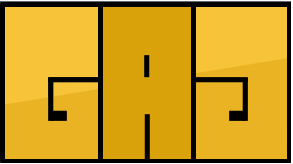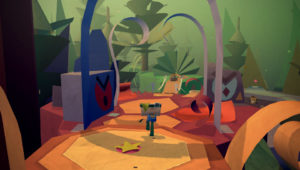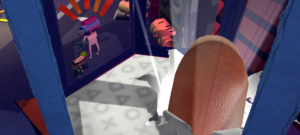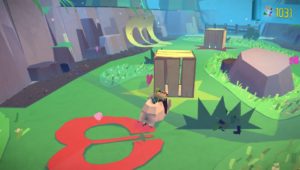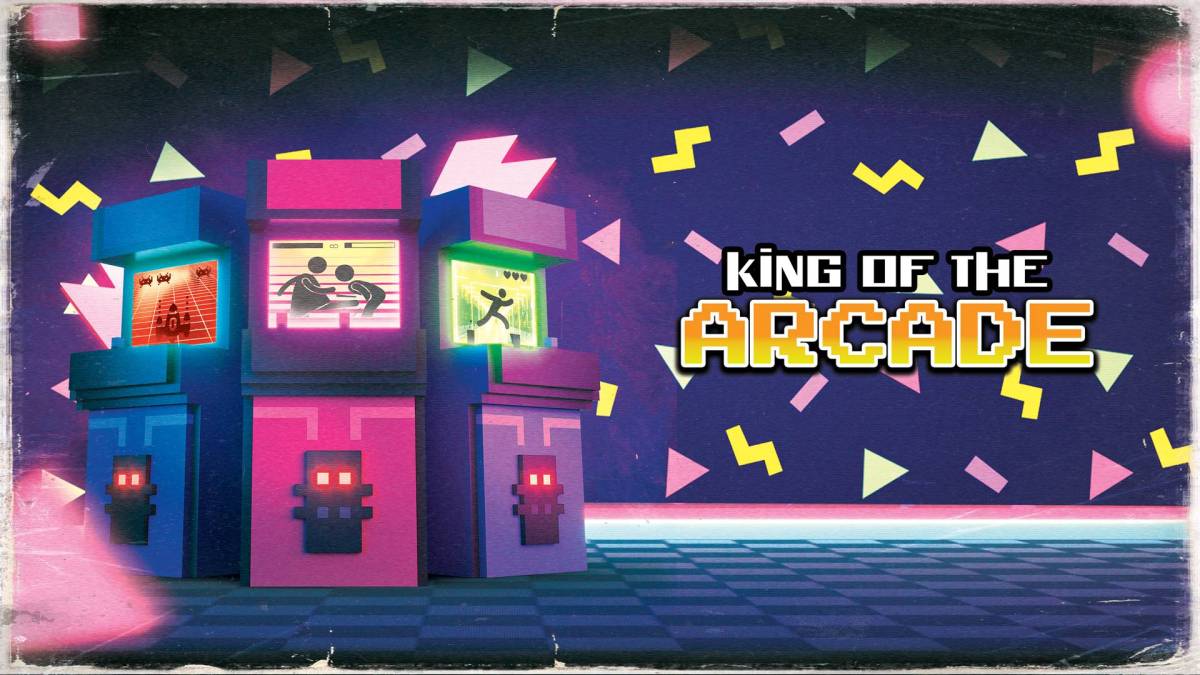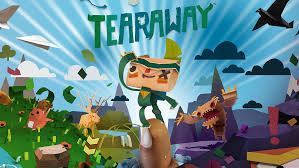
Platforms: PlayStation Vita
As you begin Tearaway it becomes apparent that Media Molecule set out to create something that was not only unique, but also special. From its papercraft world to its determination to make the player feel like they are part of the game, Tearaway’s first impressions are largely positive. As the game begins, you’ll choose whether you want to play as Iota or Atoi (male or female character options, respectively). Both characters are messengers tasked with delivering a very special message to “The You”, who is portrayed by the person playing the game. Delivering this message won’t be simple though, as the You’s world is starting to bleed into the messenger’s, creating numerous enemies known as “scraps”, who are hell bent on stopping the message from being delivered.
If I had to sum up Tearaway’s story in one word it’d be, “cute.” It’s an interesting idea that I could see a younger (or less cynical) audience being particularly enamored by, but for me it just didn’t personally make any real connection. While it didn’t necessarily click with me, there’s no denying that Tearaway has enormous heart and it was still quite refreshing to play through something with such a positive vibe. We see so much hatred, killing and death in this medium that getting little games like Tearaway is a real treat.
Tearaway’s story more than likely won’t be what draws you to the game though. Its unique gameplay, which can only really be accomplished on Vita, is the game’s most intriguing aspect. Whether it’s using the Vita’s camera to put you into the game or using the back touchpad to move platforms, bounce your messenger or destroy scraps, every aspect of Sony’s handheld gets attention. Things like using the touchscreen to unroll paper bridges or tilting the Vita to move platforms both work perfectly throughout, but I found some of the instances where the back touchpad was used were a bit finicky. There are times in Tearaway where you’ll need to poke your fingers up into the messenger’s world and I found that sometimes I’d have to move my fingers around a little too much to get a proper response from the touchpad. These issues never truly hurt the experience, but felt more like small hindrances that broke up the flow.
When you’re not using one of the Vita’s touch, tilt or camera functions, Tearaway plays like a typical Media Molecule platformer. This in and of itself comes with its own set of problems. Much like the LittleBigPlanet series, the platforming in Tearaway is very “floaty” and imprecise. This coupled with the fact that the game takes place in a 3D world can make determining just how to approach some jumps a tough endeavor. I missed more than a few jumps because the camera moved in a weird way or because I couldn’t get the precision I needed and in the worst instances because of a mixture of the two. As irritating as this can be, it’s something you eventually get used to. Tearaway is also very forgiving with its checkpoints and with absolutely no penalty for dying these sections were never enough to deter me from continuing. However, If you’re looking to get one of the game’s trophies for completing a few of the tougher levels without killing your messenger, you’re probably going to need a bit of practice and a little luck, not to mention a good deal of patience.
As slick as all of these special mechanics feel in the beginning, their luster wears off rather quickly. Constantly having to peel back tape or roll out paper bridges started feeling mundane by the end of the game. Tearaway does try to keep things fresh throughout by giving you more abilities as you progress. Unfortunately, most of them felt rather empty (some even being scarcely used once acquired) and like they were just there to give you a different button to push. For as much heart and charm as Tearaway’s world has I still couldn’t help but feel like the entire experience was a shallow one once the credits rolled. There were so many clever ideas when it came to the control scheme, but none of them ever really felt like they met their true potential.
Outside of the platforming and other gameplay, you’ll be using the Vita’s touchscreen to do a bit of arts and crafts. Whether you’re decorating your messenger with a number of pre-made accessories or creating your own paper creations, this part of Tearaway is what will make everyone’s playthrough somewhat unique. I honestly wish there was more of this in the game, but much like the implementation of touch controls, it felt like so much more could have been done. You can only put eyes and a mouth on some random animal so many times before it starts to feel a bit overused. The most fun I had with creating in Tearaway came when I was tasked with creating a specific item, like a snowflake or a flame. These actually gave me some direction and the payoff of getting to see my creation in the game world afterwards was pretty neat. Unfortunately, there were only a handful of these instances throughout the game. Granted, you can essentially create anything you want, whenever you want, but having that motivation from the game really made the experience a little more fun.
For as much grief as I’ve given Tearaway because of its shallow nature, one thing that keeps it from truly wearing out its welcome is its rather short length. The game is separated into 14 different chapters, each with its own set of collectibles and aesthetic. You could probably get through the game in around 5 or 6 hours and if you decide to go for 100% completion, you may be able to squeeze another couple of hours out of it. This could be a turn off to some, but with the game’s lack of depth if it had gone on much longer I feel like some of the fun might have been sucked out of the experience. I do feel that this is one of Tearaway’s strongest aspects because it hit that rare sweet spot where it keeps you interested in seeing what’s next without ever dragging on longer than necessary.
As I brought up earlier, collectibles are a big focus in Tearaway. In each chapter you’ll be able to collect confetti, which is also the currency of the game, and use it to purchase various decorations to doll up your messenger with. There is a set amount of confetti in each chapter, so if you return to an area you’ve previously been to you won’t be able to rack up any extra. This isn’t something that should ever be necessary because I personally never felt compelled to buy many items and ended my playthrough with over 10,000 confetti, which I’m sure is more than enough to buy every item the game has to offer. I know I keep harping on it, but the lack of stuff you can actually buy further adds to the game’s shallowness. Outside of the confetti there will also be presents to find, which are hidden throughout the levels, but sadly they only offer up more confetti.
In order to obtain 100% completion you’ll also have to find and complete all of the “extra things to do”, which are essentially just side quests that you can find in each chapter. The variety in these things to do is decent and they offer a fun break from your main quest, but unfortunately, like the presents you collect, they usually just pay out with more confetti.
Eliminating every scrap in each chapter will also be necessary if you want to complete everything. This brings up another issue I had with Tearaway – the combat. Combat is far more about evasion than actual fighting, as you’ll be juking and jiving the scraps in order to stun them, which then gives you the opportunity to toss them into a wall (or another scrap) and destroy them (giving you more confetti!). In the beginning, the combat is used sparingly and offers a fun distraction from platforming and exploration, but as the game goes on, the focus on taking out scraps becomes far too prevalent. There’s nothing mechanically wrong with the combat later in the game, but it’s just not all that fun when you have to do it frequently and for longer periods of time.
Perhaps the most fun and creative collectibles you’ll be gathering in Tearaway are papercraft plans. As you make your way through each chapter, you’ll come across various creatures and items that are completely void of color and character. Thankfully your messenger is outfitted with a camera and by pulling it out and snapping a photo of one of these items; it will become visible in the world. That probably doesn’t sound all that exciting, but with each of these you find, they’ll be added to special account you can access online that will actually let you print out patterns and directions on how to craft it in real life. This isn’t something I’m likely to ever to personally use, but I do love this idea and I have much appreciation for Media Molecule trying to expand Tearaway’s world outside of the game.
It may not be completely apparent by some of things I’ve wrote, but I enjoyed Tearaway a great deal. It is clearly a case of a game being far better than the sum of its parts. I have a lot of issues with its shallow nature and some of its execution when it comes to mechanics and story, but when it is all put together it just works. Even though they never truly felt like they reached their potential, the implementation of all of the Vita’s functionalities (touchscreen, touchpad, camera, etc.) never felt like gimmicks and all made sense in the context of the game, even if they did feel a little overused at times. Tearaway is also a game that I felt compelled to go back through and collect everything, even though all the extra confetti meant absolutely nothing to me. I just loved spending time in the beautiful and charming papercraft world that Media Molecule created. What it boils down to is simple – what you get out of Tearaway, depends greatly on what you put into it. If you go in and rush through without getting into the creation and collecting aspects, you probably won’t have too great of a time, but if you take the time to really take it all in and let your imagination run wild it might surprise you with just how enjoyable it can be. So strictly from a gameplay standpoint Tearaway is lacking quite a bit, but as an experience and a journey it is a wonderful feat that should be applauded and is one that every Vita owner should consider trying.
